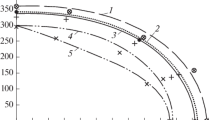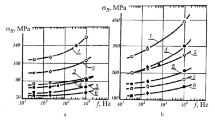The fatigue test results for specimens of structural materials are analyzed at the number of loading cycles of up to 1010. A procedure is proposed for construction of fatigue curves at large numbers of loading cycles taking into account the cycle frequency and the specimen heating temperature during testing. The comparison between the calculated results and the fatigue test data has demonstrated the validity of the procedure




Similar content being viewed by others
References
L. R. Botvina, “Gigacycle fatigue is a new problem of physics and fracture mechanics,” Zavod. Lab. Diagn. Mater., 70, No. 4, 41–51 (2004).
N. A. Makhutov, “Fatigue of metals in a wide range of the number of cycles,” Zavod. Lab. Diagn. Mater., 70, No. 4, 37–41 (2004).
L. E. Matokhnyuk, A. V. Noinalovich, and T. Yu. Yakovleva, “Fatigue resistance of materials at large numbers of loading cycles,” Zavod. Lab. Diagn. Mater., 70, No. 4, 52–56 (2004).
L. I. Domozhirov, “On the determination of the fatigue resistance characteristics in the corrosive medium at large numbers of loading cycles,” Zavod. Lab. Diagn. Mater., 68, No. 10, 41–46 (2002).
T. Yu. Yakovleva, Local Plastic Deformation and Fatigue of Metals [in Russian], Naukova Dumka, Kiev (2003).
T. Yu. Yakovleva, O. V. Voinalovich, and L. E. Matokhnyuk, “Special features of formation of a dislocation structure of a nickel alloy under cyclic loading,” Metaloznav. Obrob. Metal., No. 4, 19–25 (2001).
L. E. Matokhnyuk, Accelerated Fatigue Tests under High-Frequency Loading [in Russian], Naukova Dumka, Kiev (1988).
N. A. Makhutov and I. V. Gadolina, “Refinement of the parameters of a fatigue curve from the results of comparative tests under irregular loading to reduce technogenic risk to an acceptable level,” Matem. Model. Tekhnogen. Prirodn. Katastr., 1, No. 1, 27–30 (2009).
L. E. Matokhnyuk, I. M. Vasinyuk, A. V. Voinalovich, and A. B. Sokolinskii, “Use of high-frequency loading methods for predicting the life of materials on long-term bases,” Strength Mater., 20, No. 3, 343–348 (1988).
Author information
Authors and Affiliations
Additional information
Translated from Problemy Prochnosti, No. 5, pp. 48 – 53, September – October, 2014.
Rights and permissions
About this article
Cite this article
Pisarenko, G.G., Matokhnyuk, L.E., Voinalovych, O.V. et al. Prediction of Fatigue Resistance Characteristics of Structural Materials at Large Numbers of Loading Cycles*. Strength Mater 46, 619–624 (2014). https://doi.org/10.1007/s11223-014-9591-1
Received:
Published:
Issue Date:
DOI: https://doi.org/10.1007/s11223-014-9591-1




